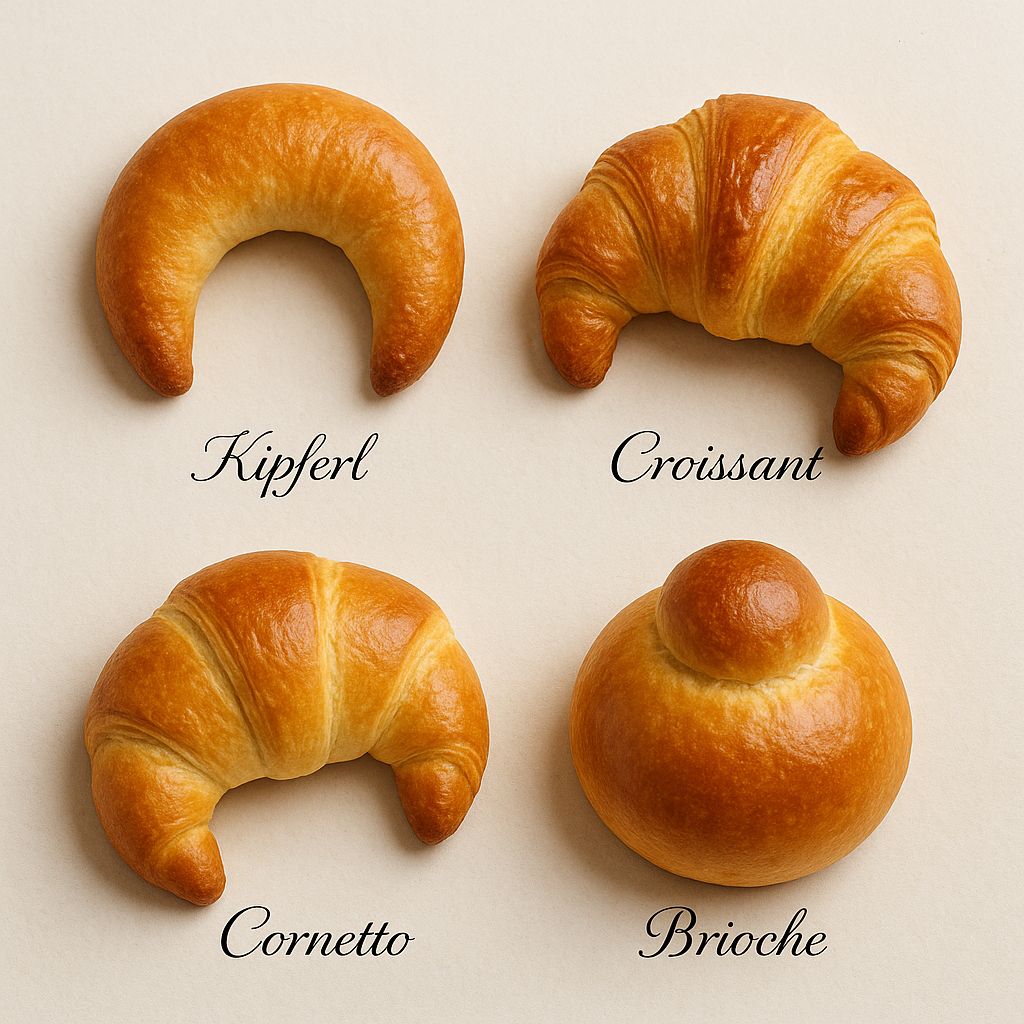The Kipferl is an Austrian crescent-shaped yeasted pastry, considered the ancestor of croissants, cornetti, brioches, and kifli.
Legend has it that these pastries were created by bakers to celebrate the end of the Turkish invasion in 1683, hence the crescent shape (in German kipferl, gipfel(e) or hörnchen).
This specialty spread to Italy and more specifically to Veneto shortly after 1683, thanks to the intense trade relations between the then Serenissima Republic of Venice and Vienna.
Its recipe was modified by the pastry chefs of Versailles, who enriched it with butter and named it croissant.
Kipferl are eaten at the end of a meal or with an afternoon drink.
In German, they are differentiated with different spelling: Kipferl compared to Kipfel for leavened bread, which is usually turned into a sandwich, sometimes plain or buttered like a fresh baguette. Often, especially for breakfast, the garnish is jam or honey.
It is believed that crescent-shaped breads or pastries were served in ancient times as offerings to the moon goddess, Selene!
Stale kipfel are used to make a sweet bread pudding called Kipfelkoch.
Not to be confused with cookies:

- Difficulty: Medium
- Cost: Economical
- Rest time: 1 Hour 30 Minutes
- Preparation time: 15 Minutes
- Cooking methods: Oven, Electric Oven
- Cuisine: Austrian
- Seasonality: All Seasons
Ingredients
- 4 cups flour
- 2/3 cup sugar (+ 1 teaspoon)
- to taste salt
- to taste lemon zest
- 1 tbsp baking powder (or 7 tsp fresh yeast)
- 1 egg (+ 1 egg yolk for brushing)
- 7 oz milk
- 1/3 cup butter
Steps
Activate the yeast:
Dissolve the yeast in 3.5 oz of lukewarm milk with a teaspoon of sugar. Let it rest for 10–15 minutes until a foam forms.
Prepare the dough:
In a large bowl, mix the flour with the sugar, salt, and lemon zest.
Add the activated yeast, the remaining milk, the egg, and melted butter.
Knead until you obtain a smooth and elastic dough.
Cover with a cloth and let rise in a warm place for about 1 hour, or until it doubles in volume.
Form the Kipferl:
Divide the dough into portions of about 3–4 oz.
Roll each portion into a triangle and roll it up from the base to the tip, forming a crescent.
Place the Kipferl on a baking sheet lined with parchment paper, cover, and let rise for another 30 minutes.
Baking:
Preheat the oven to 356°F (static).
Brush the Kipferl with the beaten egg yolk.
Bake for 15–20 minutes, until golden brown.
Brief Differences Between Kipferl, Croissant, Cornetto, and Brioche
🇦🇹 the Kipferl, not laminated, often less sweet
🇫🇷 the Croissant, buttery and laminated
🇮🇹 the Cornetto, sweeter and more fragrant
🇮🇹 🇫🇷 the Brioche, soft and rich in eggs – Shape: Sphere, braid, or with a “head” (brioche à tête)
🇦🇹 the Kipferl, not laminated, often less sweet
🇫🇷 the Croissant, buttery and laminated
🇮🇹 the Cornetto, sweeter and more fragrant
🇮🇹 🇫🇷 the Brioche, soft and rich in eggs – Shape: Sphere, braid, or with a “head” (brioche à tête)

FAQ (Questions and Answers)
Is the brioche always with a “tuppo”?
No, the brioche col tuppo is just a Sicilian variant of the brioche, characterized by the ball (“tuppo”) on top, often used to accompany ice cream or granita.
The classic French brioche, on the other hand, is more generic: it can be round, loaf-shaped, or braided, not necessarily with the “tuppo”.Which among kipferl, croissant, brioche, and cornetto was born first?

Are there other pastries in the world that can be defined as croissants? Can you name other similar recipes around the world?
Yes, there are many variants of pastries around the world that are similar to a croissant in shape or preparation, although not always made with the same type of laminated dough.
Here are some similar recipes:
Europe
Cornetto (Italy).
Brioche (France/Italy).
Kifli (Hungary): sweet or savory, often with fillings of nuts, poppy seeds, or jam.
Rugelach (Eastern Europe): a Jewish rolled pastry, similar in shape but with different dough.
Cozonac/Cozonaci (Romania): rolled leavened sweet, often filled with nuts or chocolate.
Ensaimada (Spain, Majorca): spiral pastry with lard or butter, soft.
Middle East and Asia
Sweet Samsa (Central Asia): sweet rolled versions similar to croissants.
Kifla (Balkans): like Kifli, but with variations in Serbia, Macedonia, Bosnia.
Malawach (Yemen): not sweet, but similar laminated dough, sometimes used with honey.
America
Danish (USA from Danish origin): leavened and laminated pastry, sometimes rolled, filled with cheese or fruit.
Media Luna (Argentina): similar to a croissant but sweeter and shiny.
Northern Europe
Franzbrötchen (Germany): cinnamon pastry, laminated and rolled.
All share rolling techniques or the use of buttery/yeasted doughs, although ingredients and textures vary.

